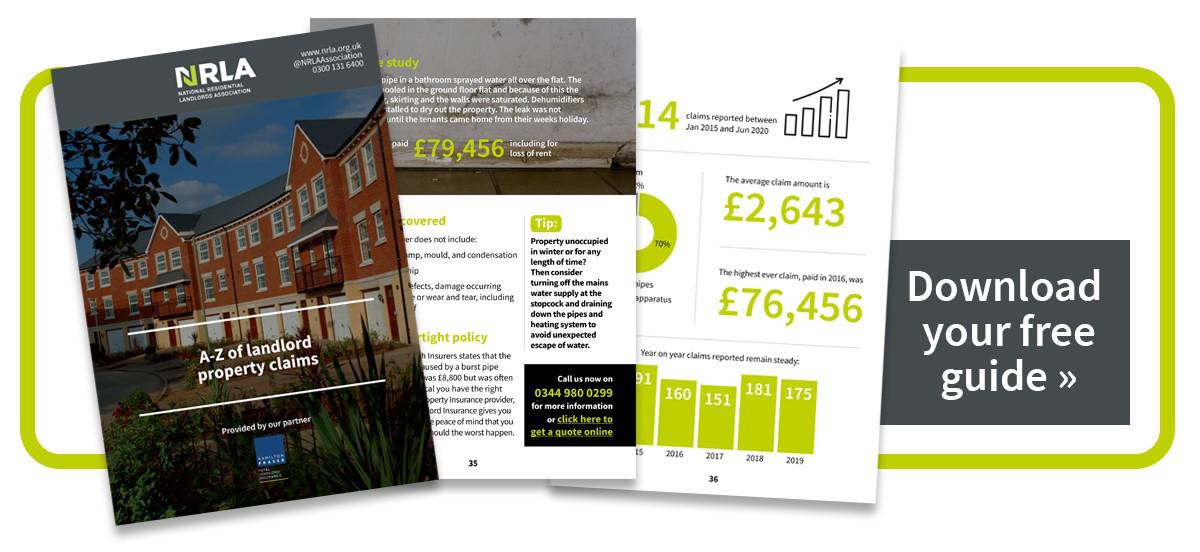

The complete guide to protecting your property from break-ins
Although landlords are ultimately responsible for keeping their rental property safe and secure, it’s in both tenants’ and landlords’ interests to work together to protect the property from break-ins. This is particularly important as we enter the summer months. With holidays back on the agenda, there’s a good chance that your tenants may be heading off for a long awaited break, leaving your property empty and potentially vulnerable to break-in.In this guide, NRLA insurance partners, Hamilton Fraser Total Landlord Insurance, share their insights into how you and your tenants can reduce your risks of being broken into.

How common are break-ins in the UK?
Property damage caused during a break-in is the third highest type of insurance claim received by Hamilton Fraser Total Landlord Insurance. In the UK, burglary following a break-in is one of the most common crimes committed, with an estimated one burglary happening every 108 seconds - that’s 34 an hour, or 816 a day.
Historical Hamilton Fraser Total Landlord Insurance data shows that break-ins see significant spikes in the summer and winter months, perhaps suggesting that increased vigilance on security practices around these times would be a good idea.
Not surprisingly, there has been a significant reduction in domestic break-ins and burglaries recently, as people have been spending more time at home during the coronavirus lockdowns. But prior to the pandemic, the general trend for break-ins was on the up. As we gradually return to normal life, it is likely that break-ins will start to increase again. So, now is a good time to make sure your property is protected.
What is the impact of break-ins?
A break in occurs when a person or persons either attempt entry or force entry into a building illegally. Being on the receiving end of a break-in is a traumatic experience for all concerned. It can take many months for victims to feel safe in their homes following the violation of a break in.
In addition to the invasion of space and loss of property, often the damage caused can be equally devastating. Hamilton Fraser Total Landlord Insurance paid out £38,355 in 2015 to repair damage following a claim made after third party culprits smashed the windows to break into a property, ripping the radiators off the walls and causing water damage throughout the property.
Given the severe psychological, financial and potentially physical, consequences of break-ins, it’s worth both landlords and tenants doing all they can to prevent them from happening in the first place.
What are the best ways to prevent a break-in?
Rented properties are generally less secure than owner-occupied properties due to the higher turnover of occupants. For example, there is nothing to stop tenants from duplicating keys, so the more tenants you have, the higher the potential risk.
There is a growing range of innovative smart security solutions, alongside more traditional practical options, to help landlords protect their rental property from a break-in. However, smart solutions can be expensive, and many of the best break-in deterrents involve good old-fashioned common sense. The more precautions you take – keeping the garden gate locked, storing valuables out of view – the more effort will be required to break in and the greater the risk of getting caught. Prevention is key and systems that can provide a visible deterrent from the outside of your property are most likely to help prevent you and your tenants being the victim of a break-in.
Next, we’ll take a look at steps landlords and tenants can take to keep their properties safe from unwanted intruders.

Seven steps landlords can take to prevent break-ins
1. Install good quality doors and windows
Most intruders break into a property through doors and windows so as a landlord it’s in your interests to install secure, good quality fittings. Installing a chain and peephole on the front door will provide peace of mind and an extra layer of security to tenants. You might also consider installing a smart doorbell - these can help increase security by detecting motion in front of the property, including a potential intruder, alerting you or your tenant to take action if required.
2. Install deadbolts and locks
These cannot be opened with a knife or credit card, so offer greater security. Hamilton Fraser Total Landlord Insurance recommend five-lever mortice deadlocks where possible. It’s also a good idea to install window locks which can be operated from the inside, particularly on the ground and first floor. If you have digital locks, be sure to frequently change the password. It is essential that this is done between tenancies, but should be done more frequently if possible.
3. Install a burglar alarm
Burglar alarms are an effective deterrent – reformed criminals report that burglars will actively avoid properties where an alarm system is installed. Make sure it’s well maintained and looks like it’s in use. Visual alarm systems that combine a sonic alarm, either an outdoor siren or a dummy siren, with a visual deterrent such as flashing lights are thought to be particularly effective.
4. Install motion sensors
Used outside the property, a sensor light will automatically illuminate dark areas close to the house and inside, motion sensors can detect the movement of any intruders.
5. Keep trees and shrubs well-trimmed
This will deter any would be intruder from attempting to hide in the vicinity of your house, as well as using trees to gain access to upstairs windows that might be unlocked.
6. Create a ‘noisy’ front garden
The more deterrents you provide, the greater the protection when it comes to increasing home security. Simple steps such as creating a ‘noisy’ gravel driveway or installing a front gate, can make a would-be intruder think twice, as well as alerting tenants if someone is approaching while they’re inside.
7. Get to know the neighbours
Communities that work together are much more likely to be vigilant, notice when things are not right and look out for each other’s properties. There may even be a neighborhood watch scheme or an online group you or your tenants could join.
How can tenants help protect your rental property from break-ins?
A good relationship between landlords and tenants, with clear expectations and lines of communication, can help both parties work together to protect a home from unwanted intruders. You might like to include the following suggestions and give them to your tenant as part of a ‘welcome pack’, along with the tenancy agreement and inventory.

Seven steps tenants can take to prevent break-ins
- Advise tenants not to hang their keys near the front door, particularly close to the letter box. An intruder can insert a device through the letter box and successfully steal keys. Just as importantly, make sure tenants never keep a key hidden outside in case they get locked out. Criminals know all the usual places to look
- Encourage tenants to keep valuables out of sight. This includes laptops and mobile phones that are often left out when not in use. Break-ins increase during the festive season, so suggest tenants minimise temptation and keep any presents hidden away from windows and doors during this period. You may even consider providing your tenants with an on-site safe for them to keep valuables in when they are away from the property
- Tell your tenants about SmartWater – it can be used to invisibly ‘tag’ valuable items. Stolen property that is retrieved by the police is scanned for SmartWater tags and returned to its owners where possible. It’s also an effective deterrent and has been used by the police to reduce burglaries
- Ask tenants to pay particular attention to garden security. An intruder is far less likely to climb over a locked gate than they are to walk through an open one, for fear of drawing unwanted attention. Sheds and garages tend to contain tools, which can be used to gain access to your home, so make sure tenants know to keep them locked too. Any doors which can’t be locked using a key should be secured using a bulky padlock and all keys should be kept in the house
- Ask tenants to make sure that all windows and doors are locked and secured at night and when they leave the property. Government statistics have shown that 30 per cent of burglaries happen through unsecured windows
- Make sure tenants know they should report any security issues to you immediately so that you can make sure they are addressed
- Make sure tenants always activate any security systems when they go out. There’s no use having a burglar alarm or motion sensors if they are not used
What can you do to minimise the risk of break-ins when your tenant is away?
It’s a good idea to include a term in your lease stipulating that the tenant must let you know if they are going to be leaving the property vacant for a given period of time (for example, over 14 days). This is useful for landlord insurance purposes, particularly if they’re going to be away for more than 30 days, but also gives you the chance to talk to your tenant about keeping the property secure while they are away, including how they can be contacted in an emergency. If your tenant is going away:
- Ask them to notify you that the property will be empty so that you or a neighbour can keep an eye on it, put bins out of the way and make sure post isn’t left hanging out of the letter box. Make sure a neighbour has your contact details so that they can reach you in the event of an emergency
- Suggest they leave lights on. You could provide your tenants with timers which can be set to turn on and off at certain times of day to give the impression that someone is at home
- Remind them to make sure any delivery services are put on hold
- Advise them not to post on social media that they are away, as this could alert potential intruders that the property is unoccupied
By working together, landlords and tenants can deter intruders from breaking into their property. But no safety measure is 100 per cent effective. Next, we’ll take a look at what happens if, despite all your efforts, your rental property is broken into: Who is responsible for repairing the damage? Does landlord insurance cover you? And what should you do if the worst happens?
Who is responsible for repairing damage caused by a break-in?
If damage has been caused to your property through criminal activity, as a landlord you are responsible for repairing the damage to either the property or to contents included in the property agreement.
However, if the tenant has broken the terms of the lease agreement and acted in a negligent way that led to the break-in or aggravated the damages incurred, the responsibility could shift to the tenant. For example, the tenant may have failed to activate the burglar alarm and left the ground floor window open while the property was empty, making the property attractive to an intruder. This is why it is very important for the landlord and the tenant to review the details of the lease agreement so that everyone is clear on the responsibilities of both parties.
It’s also important to remember that landlords are required to maintain the structure and exterior of the rental property, including windows and doors, which should close properly and seal tightly. If as a landlord you failed to repair a malfunctioning lock or a broken window, and this resulted in a break-in, you may be held liable for negligence.
If, despite taking steps to protect your property and working with your tenant to keep it secure, your property is broken into, it’s important to know that you’re covered for any damage or loss incurred.
Does landlord insurance cover break-ins?
So long as you have comprehensive landlord insurance, damage caused to your property through break-in, along with the theft of your possessions, can be claimed for through your building or contents insurance.
Both Hamilton Fraser Total Landlord Insurance’s Essential and Premier policies combine buildings and contents insurance and even include loss of rent and liability cover for landlords. Building insurance will cover the physical property for the financial cost of repairing structural damage, for example a smashed window, whereas contents insurance covers the landlord’s contents such as any furniture or appliances.
With the average break-in claim costing £2,070, it’s worth the peace of mind to know you’re covered. However, it’s important to be aware that your landlord insurance cover won’t include any contents which belong to the tenants or any pre-existing defects, damage or wear and tear.
Steve Barnes, Associate Director at Hamilton Fraser Total Landlord Insurance, offers his advice: “To avoid any misunderstanding, we recommend that you make it clear to your tenant from the outset, that they will need to take out their own insurance to cover their personal belongings or furnishings. We also suggest that, as well as an inventory, landlords keep all invoices or original purchase receipts for any items they have put in the property for the purpose of the tenancy, as these will be asked for if any items are stolen following a break-in.”

What should you do if there is a break-in?
Should you and your tenants find yourselves on the receiving end of a break-in, Hamilton Fraser Total Landlord Insurance recommend that you carry out a four-step process:
1. Report the break-in to the police. They will provide you with a crime reference number, which you will need for insurance purposes
2. If the doors or windows of the property have been damaged make them secure. For example, board up windows if the glass has been smashed to make the property secure
3. Take time-stamped photos if it is safe to do so
4. Contact your insurers to notify them of the situation and begin the claim process. They will advise you on the next steps to take
Steve Barnes sums up: “The impact of a break-in isn’t just financial – it may also affect your tenant’s sense of security in their home. It’s important to carry out any repairs quickly and to a high standard, talk to your tenant to make sure they are doing all they can to deter intruders, and reassure them that you will be taking steps to make the property secure for the future. Although you can’t remove the risk of break-ins completely, by following the advice contained in this guide and making sure you and your tenant have comprehensive insurance cover, you will be doing all you can to reduce your risks and provide peace of mind to both you and your tenants.”
For more information on claims, Hamilton Fraser Total Landlord Insurance’s A to Z of Property Claims eBook is a practical guide, packed full of useful advice to help you understand more about claims, their causes and what your policy will and won’t cover. Download your free copy in exchange for a landlord insurance quote.



